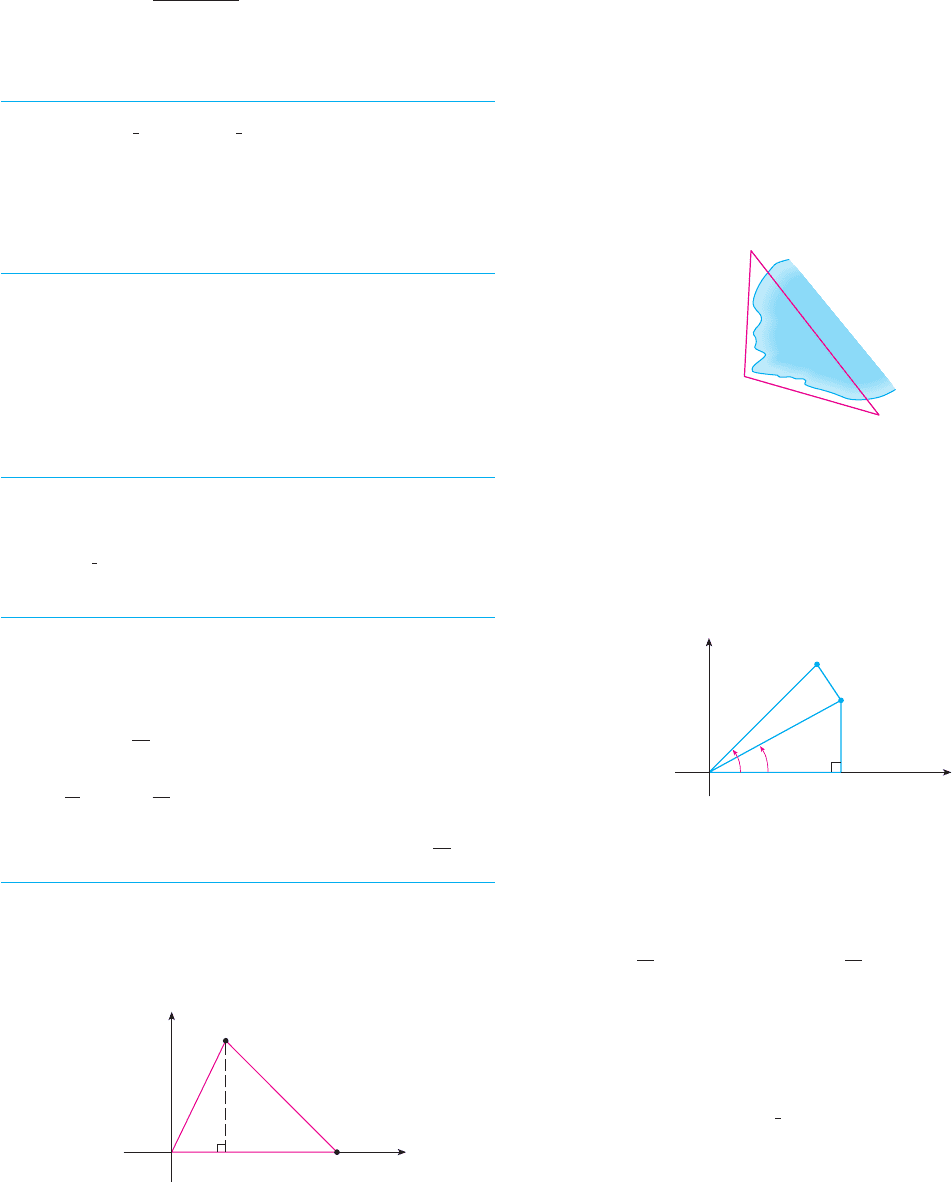Stewart J. Calculus
Подождите немного. Документ загружается.


TRIGONOMETRIC IDENTITIES
A trigonometric identity is a relationship among the trigonometric functions. The most ele-
mentary are the following, which are immediate consequences of the definitions of the trig-
onometric functions.
For the next identity we refer back to Figure 7. The distance formula (or, equivalently,
the Pythagorean Theorem) tells us that . Therefore
We have therefore proved one of the most useful of all trigonometric identities:
If we now divide both sides of Equation 7 by and use Equations 6, we get
Similarly, if we divide both sides of Equation 7 by , we get
The identities
show that is an odd function and is an even function. They are easily proved by
drawing a diagram showing and in standard position (see Exercise 39).
Since the angles and have the same terminal side, we have
These identities show that the sine and cosine functions are periodic with period .
The remaining trigonometric identities are all consequences of two basic identities
called the addition formulas:
2
cos共
2
兲 苷 cos
sin共
2
兲 苷 sin
11
2
cossin
cos共
兲 苷 cos
10b
sin共
兲 苷 sin
10a
1 cot
2
苷 csc
2
9
sin
2
tan
2
1 苷 sec
2
8
cos
2
sin
2
cos
2
苷 1
7
sin
2
cos
2
苷
y
2
r
2
x
2
r
2
苷
x
2
y
2
r
2
苷
r
2
r
2
苷 1
x
2
y
2
苷 r
2
cot
苷
cos
sin
tan
苷
sin
cos
cot
苷
1
tan
sec
苷
1
cos
csc
苷
1
sin
6
A28
||||
APPENDIX D TRIGONOMETRY
N Odd functions and even functions are
discussed in Section 1.1.

The proofs of these addition formulas are outlined in Exercises 85, 86, and 87.
By substituting for in Equations 12a and 12b and using Equations 10a and 10b,
we obtain the following subtraction formulas:
Then, by dividing the formulas in Equations 12 or Equations 13, we obtain the corre-
sponding formulas for :
If we put in the addition formulas (12), we get the double-angle formulas:
Then, by using the identity , we obtain the following alternate forms of
the double-angle formulas for :
If we now solve these equations for and , we get the following half-angle for-
mulas, which are useful in integral calculus:
Finally, we state the product formulas, which can be deduced from Equations 12
and 13:
sin
2
x 苷
1 cos 2x
2
17b
cos
2
x 苷
1 cos 2x
2
17a
sin
2
xcos
2
x
cos 2x 苷 1 2 sin
2
x
16b
cos 2x 苷 2 cos
2
x 1
16a
cos 2x
sin
2
x cos
2
x 苷 1
cos 2x 苷 cos
2
x sin
2
x
15b
sin 2x 苷 2 sin x cos x
15a
y 苷 x
tan共x y兲 苷
tan x tan y
1 tan x tan y
14b
tan共x y兲 苷
tan x tan y
1 tan x tan y
14a
tan共x y兲
cos共x y兲 苷 cos x cos y sin x sin y
13b
sin共x y兲 苷 sin x cos y cos x sin y
13a
yy
cos共x y兲 苷 cos x cos y sin x sin y
12b
sin共x y兲 苷 sin x cos y cos x sin y
12a
APPENDIX D TRIGONOMETRY
||||
A29

There are many other trigonometric identities, but those we have stated are the ones
used most often in calculus. If you forget any of them, remember that they can all be
deduced from Equations 12a and 12b.
EXAMPLE 6 Find all values of in the interval such that .
SOLUTION Using the double-angle formula (15a), we rewrite the given equation as
Therefore, there are two possibilities:
The given equation has five solutions: , , , , and . M
GRAPHS OF THE TRIGONOMETRIC FUNCTIONS
The graph of the function , shown in Figure 13(a), is obtained by plotting
points for and then using the periodic nature of the function (from Equa-
tion 11) to complete the graph. Notice that the zeros of the sine function occur at the
FIGURE 13
y
1
_1
x
π_π
2π
3π
0
_
π
2
π
2
3π
2
5π
2
(b) ©=cosx
y
1
_1
0x
π_π
2π 3π
_
π
2
π
2
3π
2
5π
2
(a) ƒ=sinx
0 x 2
f 共x兲 苷 sin x
2
5
兾3
兾30
x 苷 or x 苷
3
,
5
3
x 苷 0,
, 2
or
cos x 苷
1
2
sin x 苷 0 or 1 2 cos x 苷 0
sin x 共1 2 cos x兲 苷 0orsin x 苷 2 sin x cos x
sin x 苷 sin 2x关0, 2
兴x
sin x sin y 苷
1
2
关cos共x y兲 cos共x y兲兴
18c
cos x cos y 苷
1
2
关cos共x y兲 cos共x y兲兴
18b
sin x cos y 苷
1
2
关sin共x y兲 sin共x y兲兴
18a
A30
||||
APPENDIX D TRIGONOMETRY

integer multiples of , that is,
Because of the identity
(which can be verified using Equation 12a), the graph of cosine is obtained by shifting the
graph of sine by an amount to the left [see Figure 13(b)]. Note that for both the sine
and cosine functions the domain is and the range is the closed interval .
Thus, for all values of , we have
The graphs of the remaining four trigonometric functions are shown in Figure 14 and
their domains are indicated there. Notice that tangent and cotangent have range ,
whereas cosecant and secant have range . All four functions are peri-
odic: tangent and cotangent have period , whereas cosecant and secant have period .
FIGURE 14
(c) y=cscx
y
1
_1
0
x
π
y=sinx
_
π
2
π
2
3π
2
(d) y=secx
y
0
x
π
_π
_1
1
y=cosx
_
π
2
π
2
3π
2
(a) y=tanx (b) y=cotx
y
0x
π_π
_
π
2
π
2
3π
2
y
1
_1
0
x
π
_π
_
π
2
π
2
3π
2
2
共, 1兴 傼 关1, 兲
共, 兲
1 cos x 11 sin x 1
x
关1, 1兴共, 兲
兾2
cos x 苷 sin
冉
x
2
冊
whenever x 苷 n
, n an integersin x 苷 0
APPENDIX D TRIGONOMETRY
||||
A31

A32
||||
APPENDIX D TRIGONOMETRY
34. ,
35–38 Find, correct to five decimal places, the length of the side
labeled .
35. 36.
37. 38.
39– 41 Prove each equation.
39. (a) Equation 10a (b) Equation 10b
40. (a) Equation 14a (b) Equation 14b
41. (a) Equation 18a (b) Equation 18b
(c) Equation 18c
42–58 Prove the identity.
42.
43. 44.
45. 46.
47.
48.
49.
50.
51.
52.
53.
54.
55.
sin
1 cos
苷 csc
cot
sin
2
x sin
2
y 苷 sin共x y兲 sin共x y兲
sin x sin 2x cos x cos 2x 苷 cos x
1
1 sin
1
1 sin
苷 2 sec
2
tan 2
苷
2 tan
1 tan
2
2 csc 2t 苷 sec t csc t
cot
2
sec
2
苷 tan
2
csc
2
tan
2
sin
2
苷 tan
2
sin
2
sec y cos y 苷 tan y sin y
共sin x cos x兲
2
苷 1 sin 2xsin
cot
苷 cos
sin共
x兲 苷 sin xsin
冉
2
x
冊
苷 cos x
cos
冉
2
x
冊
苷 sin x
22cm
x
3π
8
8cm
x
2π
5
25 cm
x
40°
10 cm
x
35°
x
3
2
2
csc
苷
4
3
1–6 Convert from degrees to radians.
1. 2. 3.
4. 5. 6.
7–12 Convert from radians to degrees.
7. 8. 9.
10. 11. 12.
13. Find the length of a circular arc subtended by an angle of
rad if the radius of the circle is 36 cm.
14. If a circle has radius 10 cm, find the length of the arc
subtended by a central angle of .
15. A circle has radius m. What angle is subtended at the center
of the circle by an arc 1 m long?
16. Find the radius of a circular sector with angle and arc
length 6 cm.
17–22 Draw, in standard position, the angle whose measure is
given.
17. 18. 19. rad
20. rad 21. rad 22. rad
23–28 Find the exact trigonometric ratios for the angle whose
radian measure is given.
23. 24. 25.
26. 27. 28.
29–34 Find the remaining trigonometric ratios.
29. ,
30. ,
31. ,
32. ,
33. ,
2
cot
苷 3
x
3
2
cos x 苷
1
3
2
sec
苷 1.5
0
2
tan
苷 2
0
2
sin
苷
3
5
11
4
5
6
5
9
2
4
3
3
4
32
7
3
3
4
150315
3
兾4
1.5
72
兾12
5
3
8
8
3
5
12
7
2
4
36900315
9300210
EXERCISES
D

APPENDIX D TRIGONOMETRY
||||
A33
position as in the figure. Express and in terms of and then
use the distance formula to compute .]
84. In order to find the distance across a small inlet, a point
is located as in the figure and the following measurements
were recorded:
mm
Use the Law of Cosines from Exercise 83 to find the required
distance.
85. Use the figure to prove the subtraction formula
[Hint: Compute in two ways (using the Law of Cosines from
Exercise 83 and also using the distance formula) and compare
the two expressions.]
86. Use the formula in Exercise 85 to prove the addition formula
for cosine (12b).
87. Use the addition formula for cosine and the identities
to prove the subtraction formula for the sine function.
88. Show that the area of a triangle with sides of lengths and
and with included angle is
89. Find the area of triangle , correct to five decimal places, if
cm cm ⬔ABC 苷 107
ⱍ
BC
ⱍ
苷 3
ⱍ
AB
ⱍ
苷 10
ABC
A 苷
1
2
ab sin
ba
sin
冉
2
冊
苷 cos
cos
冉
2
冊
苷 sin
0
y
B(cos∫,sin∫)
∫
1
A
(coså,sinå)
1
å
c
x
c
2
cos共
兲 苷 cos
cos
sin
sin
A
C
B
ⱍ
BC
ⱍ
苷 910
ⱍ
AC
ⱍ
苷 820⬔C 苷 103
C
ⱍ
AB
ⱍ
c
yx
56.
57.
58.
59–64 If and , where and lie between and
, evaluate the expression.
59. 60.
61. 62.
63. 64.
65–72 Find all values of in the interval that satisfy the
equation.
65. 66.
67. 68.
69. 70.
71. 72.
73–76 Find all values of in the interval that satisfy the
inequality.
73. 74.
75. 76.
77–82 Graph the function by starting with the graphs in Figures 13
and 14 and applying the transformations of Section 1.3 where
appropriate.
77. 78.
79. 80.
81. 82.
83. Prove the Law of Cosines: If a triangle has sides with lengths
, , and , and is the angle between the sides with lengths
and , then
[Hint: Introduce a coordinate system so that is in standard
0
y
P(x,y)
¨
cb
(a,0)
x
c
2
苷 a
2
b
2
2ab cos
b
a
cba
y 苷 2 sin
冉
x
4
冊
y 苷
ⱍ
sin x
ⱍ
y 苷 1 sec xy 苷
1
3
tan
冉
x
2
冊
y 苷 tan 2xy 苷 cos
冉
x
3
冊
sin x cos x
1
tan x
1
2cos x 1 0sin x
1
2
关0, 2
兴x
2 cos 2x 苷 3 cos xsin x 苷 tan x
2 cos x sin 2x 苷 0sin 2x 苷 cos x
ⱍ
tan x
ⱍ
苷 12 sin
2
x 苷 1
3 cot
2
x 苷 12 cos x 1 苷 0
关0, 2
兴x
cos 2ysin 2y
sin共x y兲cos共x y兲
cos共x y兲sin共x y兲
兾2
0yxsec y 苷
5
4
sin x 苷
1
3
cos 3
苷 4 cos
3
3 cos
sin 3
sin
苷 2 sin 2
cos
tan x tan y 苷
sin共x y兲
cos x cos y

SIGMA NOTATION
A convenient way of writing sums uses the Greek letter (capital sigma, corresponding to
our letter S) and is called sigma notation.
DEFINITION If are real numbers and and are integers
such that then
With function notation, Definition 1 can be written as
Thus the symbol indicates a summation in which the letter (called the index of
summation) takes on consecutive integer values beginning with m and ending with n, that
is, . Other letters can also be used as the index of summation.
EXAMPLE 1
(a)
(b)
(c)
(d)
(e)
(f) M
EXAMPLE 2 Write the sum in sigma notation.
SOLUTION There is no unique way of writing a sum in sigma notation. We could write
or
or M
The following theorem gives three simple rules for working with sigma notation.
2
3
3
3
n
3
苷
兺
n2
k苷0
共k 2兲
3
2
3
3
3
n
3
苷
兺
n1
j苷1
共 j 1兲
3
2
3
3
3
n
3
苷
兺
n
i苷2
i
3
2
3
3
3
n
3
兺
4
i苷1
2 苷 2 2 2 2 苷 8
兺
3
i苷1
i 1
i
2
3
苷
1 1
1
2
3
2 1
2
2
3
3 1
3
2
3
苷 0
1
7
1
6
苷
13
42
兺
n
k苷1
1
k
苷 1
1
2
1
3
1
n
兺
5
j苷0
2
j
苷 2
0
2
1
2
2
2
3
2
4
2
5
苷 63
兺
n
i苷3
i 苷 3 4 5 共n 1兲 n
兺
4
i苷1
i
2
苷 1
2
2
2
3
2
4
2
苷 30
m, m 1, ..., n
i
冘
n
i苷m
兺
n
i苷m
f 共i兲 苷 f 共m兲 f 共m 1兲 f 共m 2兲 f 共n 1兲 f 共n兲
兺
n
i苷m
a
i
苷 a
m
a
m1
a
m2
a
n1
a
n
m n,
nma
m
, a
m1
, ..., a
n
1
冘
E
A34
||||
APPENDIX E SIGMA NOTATION
This tells us to
end with i=n.
This tells us
to add.
This tells us to
start with i=m.
μ
a
i
n
im

THEOREM If is any constant (that is, it does not depend on ), then
(a) (b)
(c)
PROOF To see why these rules are true, all we have to do is write both sides in expanded
form. Rule (a) is just the distributive property of real numbers:
Rule (b) follows from the associative and commutative properties:
Rule (c) is proved similarly. M
EXAMPLE 3 Find
SOLUTION M
EXAMPLE 4 Prove the formula for the sum of the first positive integers:
SOLUTION This formula can be proved by mathematical induction (see page 77) or by the
following method used by the German mathematician Karl Friedrich Gauss (1777–1855)
when he was ten years old.
Write the sum twice, once in the usual order and once in reverse order:
Adding all columns vertically, we get
On the right side there are terms, each of which is , so
M
EXAMPLE 5 Prove the formula for the sum of the squares of the first positive
integers:
兺
n
i苷1
i
2
苷 1
2
2
2
3
2
n
2
苷
n共n 1兲共2n 1兲
6
n
S 苷
n共n 1兲
2
or2S 苷 n共n 1兲
n 1n
2S 苷 共n 1兲 共n 1兲 共n 1兲 共n 1兲 共n 1兲
S 苷 n 共n 1兲 共n 2兲 2 1
S 苷 1 2 3 共n 1兲 n
S
兺
n
i苷1
i 苷 1 2 3 n 苷
n共n 1兲
2
n
兺
n
i苷1
1 苷 1 1 1 苷 n
兺
n
i苷1
1.
苷 共a
m
a
m1
a
n
兲 共b
m
b
m1
b
n
兲
共a
m
b
m
兲 共a
m1
b
m1
兲 共a
n
b
n
兲
ca
m
ca
m1
ca
n
苷 c共a
m
a
m1
a
n
兲
兺
n
i苷m
共a
i
b
i
兲 苷
兺
n
i苷m
a
i
兺
n
i苷m
b
i
兺
n
i苷m
共a
i
b
i
兲 苷
兺
n
i苷m
a
i
兺
n
i苷m
b
i
兺
n
i苷m
ca
i
苷 c
兺
n
i苷m
a
i
ic
2
APPENDIX E SIGMA NOTATION
||||
A35
n terms

SOLUTION 1 Let be the desired sum. We start with the telescoping sum (or collapsing
sum):
On the other hand, using Theorem 2 and Examples 3 and 4, we have
Thus we have
Solving this equation for , we obtain
or
SOLUTION 2 Let be the given formula.
1. is true because
2. Assume that is true; that is,
Then
So is true.
By the Principle of Mathematical Induction, is true for all . M
nS
n
S
k1
苷
共k 1兲关共k 1兲 1兴关2共k 1兲 1兴
6
苷
共k 1兲共k 2兲共2k 3兲
6
苷 共k 1兲
2k
2
7k 6
6
苷 共k 1兲
k共2k 1兲 6共k 1兲
6
苷
k共k 1兲共2k 1兲
6
共k 1兲
2
1
2
2
2
3
2
共k 1兲
2
苷 共1
2
2
2
3
2
k
2
兲 共k 1兲
2
1
2
2
2
3
2
k
2
苷
k共k 1兲共2k 1兲
6
S
k
1
2
苷
1共1 1兲共2 ⴢ 1 1兲
6
S
1
S
n
S 苷
2n
3
3n
2
n
6
苷
n共n 1兲共2n 1兲
6
3 S 苷 n
3
3
2
n
2
1
2
n
S
n
3
3n
2
3n 苷 3S
3
2
n
2
5
2
n
苷 3S 3
n共n 1兲
2
n 苷 3S
3
2
n
2
5
2
n
兺
n
i苷1
关共1 i 兲
3
i
3
兴 苷
兺
n
i苷1
关3i
2
3i 1兴 苷 3
兺
n
i苷1
i
2
3
兺
n
i苷1
i
兺
n
i苷1
1
苷 共n 1兲
3
1
3
苷 n
3
3n
2
3n
兺
n
i苷1
关共1 i兲
3
i
3
兴 苷 共2
3
1
3
兲 共3
3
2
3
兲 共4
3
3
3
兲 关共n 1兲
3
n
3
兴
S
A36
||||
APPENDIX E SIGMA NOTATION
Most terms cancel in pairs.
N See pages 55 and 58 for a more thorough
discussion of mathematical induction.
N PRINCIPLE OF MATHEMATICAL INDUCTION
Let be a statement involving the positive inte-
ger . Suppose that
1. is true.
2. If is true, then is true.
Then is true for all positive integers .nS
n
S
k1
S
k
S
1
n
S
n

We list the results of Examples 3, 4, and 5 together with a similar result for cubes (see
Exercises 37–40) as Theorem 3. These formulas are needed for finding areas and evalu-
ating integrals in Chapter 5.
THEOREM
Let be a constant and a positive integer. Then
(a) (b)
(c) (d)
(e)
EXAMPLE 6
Evaluate .
SOLUTION
Using Theorems 2 and 3, we have
M
EXAMPLE 7
Find .
SOLUTION
M
苷
1
2
ⴢ 1 ⴢ 1 ⴢ 2 3 苷 4
苷 lim
n l
冋
1
2
ⴢ 1
冉
1
1
n
冊冉
2
1
n
冊
3
册
苷 lim
n l
冋
1
2
ⴢ
n
n
ⴢ
冉
n 1
n
冊冉
2n 1
n
冊
3
册
苷 lim
n l
冋
3
n
3
n共n 1兲共2n 1兲
6
3
n
ⴢ n
册
苷 lim
n
l
冋
3
n
3
兺
n
i苷1
i
2
3
n
兺
n
i苷1
1
册
lim
n l
兺
n
i苷1
3
n
冋冉
i
n
冊
2
1
册
苷 lim
n l
兺
n
i苷1
冋
3
n
3
i
2
3
n
册
lim
n l
兺
n
i苷1
3
n
冋冉
i
n
冊
2
1
册
苷
n共n 1兲共2n
2
2n 3兲
2
苷
n共n 1兲关2n共n 1兲 3兴
2
苷 4
冋
n共n 1兲
2
册
2
3
n共n 1兲
2
兺
n
i苷1
i共4i
2
3兲 苷
兺
n
i苷1
共4i
3
3i兲 苷 4
兺
n
i苷1
i
3
3
兺
n
i苷1
i
兺
n
i苷1
i共4i
2
3兲
兺
n
i苷1
i
3
苷
冋
n共n 1兲
2
册
2
兺
n
i苷1
i
2
苷
n共n 1兲共2n 1兲
6
兺
n
i苷1
i 苷
n共n 1兲
2
兺
n
i苷1
c 苷 nc
兺
n
i苷1
1 苷 n
nc
3
APPENDIX E SIGMA NOTATION
||||
A37
N
The type of calculation in Example 7 arises
in Chapter 5 when we compute areas.
Openmirrors.com
